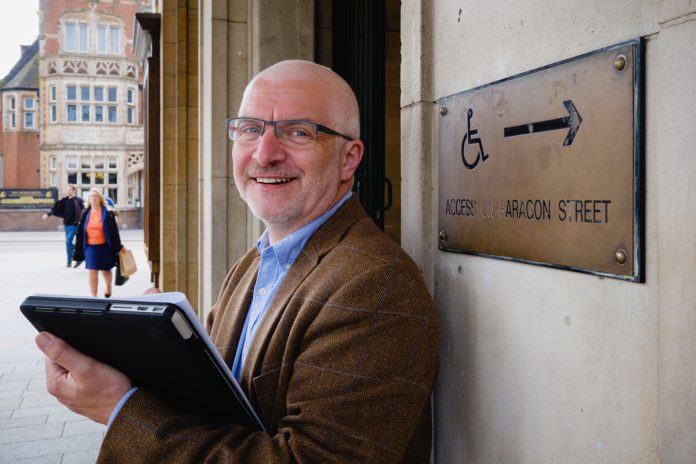Ian Streets, managing director of About Access, says consultation is key when it comes to making art and culture accessible to all
Opened just over a year ago as Scotland’s first design museum, you’d expect the V&A Dundee to leave nothing to chance in making sure its own design is as accessible as possible.
Accolades have indeed followed for a facility that has accessible loos on all floors, a Changing Places toilet on one floor, lift access throughout and plenty of space to accommodate wheelchairs.
The challenge is to extend such accessibility to all museums and galleries. Realistically, it’s one that can never be met fully because of the age and condition of so many of the properties, but this is why we have the requirement for reasonable adjustments.
It’s also why the Arts Council is “committed to ensuring that the physical environment does not create barriers to creativity, participation, learning and involvement”. It follows, therefore, that making premises and performances more accessible will improve the chances of funding bids.
We find from our work in towns and cities throughout the UK that addressing accessibility within the criteria for funding can certainly help bidders to focus on the needs of disabled people, and there are still many organisations that work to make their facilities more accessible simply because it’s the right thing to do.
However, we also find that the scope of an access audit of a museum or gallery is not always as wide as it could be. The operators of the premises might be well versed in the issues of getting to the building in the first place, getting into it, moving around it and using the facilities that are provided, but too often they overlook the need to provide assistance with interpreting the actual exhibits.
It’s all very well ensuring the WCs, baby changing, café and gift shop are up to accessible standards, but people need to be able to enjoy and understand the displays – the very things that attract them there in the first place.
In all the examples we saw during our recent work, the interpretation failed to a greater or lesser degree.
One display was placed on a wall halfway along a ramp, making it difficult for wheelchair users to pause and take in the information. Another display was accompanied by text that was very difficult to read. The font was unsuitable and the spacing between words was too small.
Sometimes glass is placed over a piece of text, causing problems with reflections, and sometimes the entire display is located in an area that is too dark for people with even a slight visual impairment to make out the detail. Even where light and shade do not present problems, some text displays are positioned too high, too low or in an area where a display cannot be viewed by people who have a fixed position, such as a wheelchair user.
Obviously, any visual display creates difficulties for someone who is blind or partially sighted, which raised an interesting question at one of our consultation groups comprising people with first-hand experience of a range of impairments.
The group suggested that an adjustment which makes life easier for someone with a particular type of impairment might at the same time add to the inconvenience for someone who has a different disability.
One contributor who has a profound visual impairment suggested that a braille guidebook would be helpful. However, the volume of information in many cultural venues is such that the book could end up being very cumbersome. Separate books for different departments – or even for individual exhibits – would make life easier. Better still is an audio guide, but that’s no use to someone with a hearing impairment who, according to our group, may also struggle with large volumes of written text.
Some places replicate paintings and other exhibits in 3D, enabling people to touch and feel the detail. And how about apps on smartphones? Our panel liked the idea of that but pointed out that many people who would benefit might not be that comfortable with the technology.
Signage was identified as another issue – signs should be clear, bold and visible from wheelchair level, indicating key points such as toilets and also displayed on the inside of the toilet door to help people find their way out.
The solution which was generally acceptable to all was to use tour guides, who would need to be knowledgeable about the exhibits and displays, and trained to meet the needs of visitors who might have a variety of impairments.
This in itself raises questions about the range of skills required, from leading people on a fully guided tour to helping with orientation and signposting for those who prefer a less formal approach, and informing people about the availability of such equipment as audio guides.
It was clear to us that there is a need for more staff to undergo disability confidence training, perhaps with a specific focus on certain types of impairment. The plus was that more museum and gallery operators seem to be consulting with disabled people and their representatives. The next step is for them to make more people aware of that, and to generate more feedback as a result.
Ian Streets advises public and private sector bodies and businesses on accessibility legislation, issues and best practice.
About Access Ltd, 63 Wilson St, Anlaby, Hull, East Yorkshire, HU10 7AJ. Tel 01482 651101, Email ian@aboutaccess.co.uk Website www.aboutaccess.co.uk.
Ian Streets
Managing Director
About Access
Tel: +44 (0)1482 651101
Please note: this is a commercial profile.














